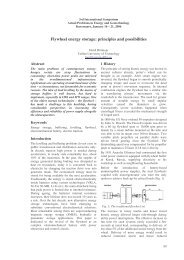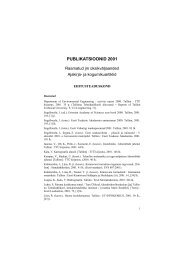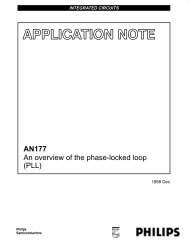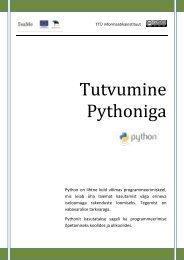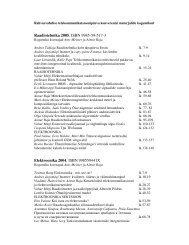Toward Systematic Design of Fault- Tolerant Systems
Toward Systematic Design of Fault- Tolerant Systems
Toward Systematic Design of Fault- Tolerant Systems
You also want an ePaper? Increase the reach of your titles
YUMPU automatically turns print PDFs into web optimized ePapers that Google loves.
.The possiblecauses <strong>of</strong>faultsincludenaturalphenomena<strong>of</strong> internalor externalorigin, andaccidentalor intentionalhumanactions.C. Gilley, Francis P. Mathur, David A. Rennels, JohnA. Rohr, and David K. Rubin) culminated in a laboratorymodel <strong>of</strong> the JPL-STAR computer. 6 US PatentNo. 3,517,671 granted to me in 1970 and assignedto NASA, validated the concept’s originality. A flightmodel <strong>of</strong> the JPL-STAR was designed for a 10- to 15-year space mission, 6 but construction stopped whenNASA discontinued the Grand Tour mission.Nevertheless, the project did afford the study <strong>of</strong> allaccessible engineering solutions and theory concerningreliability. From a confusing variety <strong>of</strong> theoriesand techniques 2-5 emerged the unifying concept <strong>of</strong>fault tolerance. 1 And in 1971 JPL and the IEEEComputer Society cosponsored the first InternationalSymposium on <strong>Fault</strong>-<strong>Tolerant</strong> Computing.During the succeeding 25 years the set <strong>of</strong> faults thatfault-tolerant systems had to tolerate grew extensively.The original concept dealt with transient and permanentlogic faults <strong>of</strong> physical origin. The increasing complexity<strong>of</strong> s<strong>of</strong>tware and VLSI chip logic emphasized theimpossibility <strong>of</strong> removing all design faults prior to operation.Thus, faults due to human design errors wereadded to the demands <strong>of</strong> fault tolerance. Experiencealso led to the addition <strong>of</strong> interaction faults—thosefaults inadvertently introduced by humans during computeroperation or maintenance. Finally, consequences<strong>of</strong> malicious actions intended to alter or interrupt servicewere recognized as intentional design faults. Thisconcept established a common ground for the unifiedtreatment <strong>of</strong> security and fault tolerance concerns insystem design. Assuring full compatibility and integration<strong>of</strong> security and fault tolerance techniques is amajor challenge for contemporary designers.The possible causes <strong>of</strong> faults, then, include naturalphenomena <strong>of</strong> internal or external origin and accidentalor intentional human actions. In either case,faults will cause errors. If error detection and recoverydo not take place in a timely manner, a failure willoccur that will be manifested by the denial or an undesirablechange <strong>of</strong> service.There are two ways to build a fault-tolerant system.The bottom-up approach entails designing aninfrastructure <strong>of</strong> autonomously fault-tolerant subsystems(microprocessors, memories, sensors, displays,and so on) and integrating this infrastructurewith global fault tolerance functions such as reconfigurationand externally supported recovery. The topdownapproach allows a system to be built usingexisting (<strong>of</strong>f-the-shelf) subsystems that may have littleor no fault tolerance at all. A global monitoringfunction is then implemented to provide fault tolerance.Top-down design is the prevailing practice.An examination <strong>of</strong> both approaches clearly makesa case for the long-range merits <strong>of</strong> the bottom-up technique.Moreover, similarities between fault toleranceand the human immune system suggest an analogythat <strong>of</strong>fers developers and users <strong>of</strong> high-confidencesystems a greater understanding and acceptance <strong>of</strong>bottom-up fault tolerance.DESIGN PARADIGM FORFAULT-TOLERANT SYSTEMSBuilding the JPL-STAR computer involved muchimprovisation and experimentation with design alternatives.It became apparent that the lessons learnedcould serve as the foundation for a more orderlyapproach that would guide designers in treating faulttolerance as a systematic issue.My 1967 paper 1 was followed by publications overthe next 25 years that formulated an evolving view <strong>of</strong>how to systematically introduce fault tolerance inhardware, s<strong>of</strong>tware, communication, and manmachine-interfacesubsystems and how to integratethese elements during design. 2 The appearance <strong>of</strong> new,successful fault-tolerant systems <strong>of</strong>fered additionaldesign insights and more operational experience.Here I summarize the most mature version <strong>of</strong> theguidelines for bottom-up fault tolerance. An abstraction<strong>of</strong> observed design processes in which steps <strong>of</strong>tenoverlap, it is <strong>of</strong>fered as a way to minimize the probability<strong>of</strong> oversights, mistakes, and inconsistencies thatmay occur during the implementation <strong>of</strong> fault tolerance.The first three steps—specification, implementation,and evaluation—deal with the building <strong>of</strong> anew system. Implementation and evaluation are concurrent.Step four—modification—addresses therepair or augmentation <strong>of</strong> an existing design.SpecificationSystem requirements that describe the services to bedelivered in terms <strong>of</strong> functionality and performanceare the starting point in specifying fault tolerance.Mission phases. First we identify different phases,characterized by different environments and operationconditions during the system’s lifetime or mission.Dependability conditions. Then we identify fourdependability conditions for each phase:• <strong>Fault</strong> classes. I have already summarized thepotential fault classes to be tolerated. Environmentalconditions and operating interfaces willaffect the expected fault classes. Each missionphase may encounter internal faults that arisewithin the system and external faults that introduceerrors into the system via the interfaces: I/Olinks, external fault tolerance support, andhuman-machine interaction.• External support. Here we determine the availability<strong>of</strong> repair by external agents and the form<strong>of</strong> this support (on-demand or periodic) as well as52 Computer




